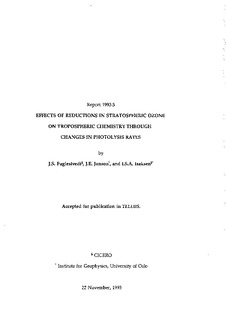| dc.description.abstract | The observed reductions in stratospheric ozone since the late 1970s are likely to have affected the penetration of UV radiation into the troposphere. We have examined the sensitivity and the response of the tropospheric chemistry to such changes in UV radiation. Based on observations of ozone column densities and model calculations of changes in the ozone column densities after 1970, photodissociation rates for selected years (1970, 1980, 1990, 2000 and 2050) are calculated. These calculations give significant changes in the dissociation rates of some gases, particularly in the dissociation rate for O3 yielding O('D). This increase in photodissociation rates initiates increases in tropospheric OH. However, the model studies show that the OH changes are somewhat damped compared to the changes in short wave radiation due to strong interactions between key species in the troposphere. Ozone is reduced in most areas when the UV radiation increases, but the percentage reductions in ozone are significantly smaller than the percentage UV increases. However, during spring, O3 increases in regions where NOx is enhanced. The calculations give increased levels of H2O2, although the magnitude of the response varies considerably with time of year and with region, and they are largest at high latitudes during spring. The relative changes in methane are found to be less than the relative changes in global average of OH since the largest relative OH changes take place outside the region of most importance for the methane oxidation (low latitudes and low altitudes). In addition, the effect is delayed in accordance with the chemical lifetime of methane (~10 years). The results indicate that increased fluxes of UV due to reduced ozone columns may have contributed to the reduction in the growth rate of methane, and the magnitude of this effect is estimated to ~1 /3 of the reduction. It is therefore unlikely that changes in UV fluxes is the main cause of the reduction in the growth rate of methane which has been observed during the 1980s. The mechanism constitutes a negative indirect chemical effect on climate from the ozone depleting substances, mainly the CFCS.
Det er observert reduksjoner i stratosfærisk O3, hvilket har økt innstrålingen av UV til troposfæren. UV-strålingen driver den kjemiske omsetningen i troposfæren, og ved hjelp av modeller og observasjonsdata studeres kjemiske responser på UV-økning. Resultatene viser betydelige økninger i fotolyserater, spesielt i fotolysen av O3 som initierer produksjon av OH; den viktigste oksidanten i troposfæren. Men pga. interaksjoner i kjemien blir denne økningen noe dempet. Nivåene av troposfærisk O3 reduseres, bortsett fra i vårmånedene i områder med høye NOx konsentrasjoner, der en får en viss økning. H2O2 viser markerte økninger som varierer sterkt med årstid og breddegrad. Beregningene indikerer også at de økte OH-nivåene fører til reduserte veksthastigheter for CH4-konsentrasjonen, men at dette bare kan forklare ~1/3 av den observerte reduksjonen. Siden KFK bryter ned stratosfærisk O3 har disse gassene negative indirekte effekter på klimaet via de studerte mekanismene. | nb_NO |
